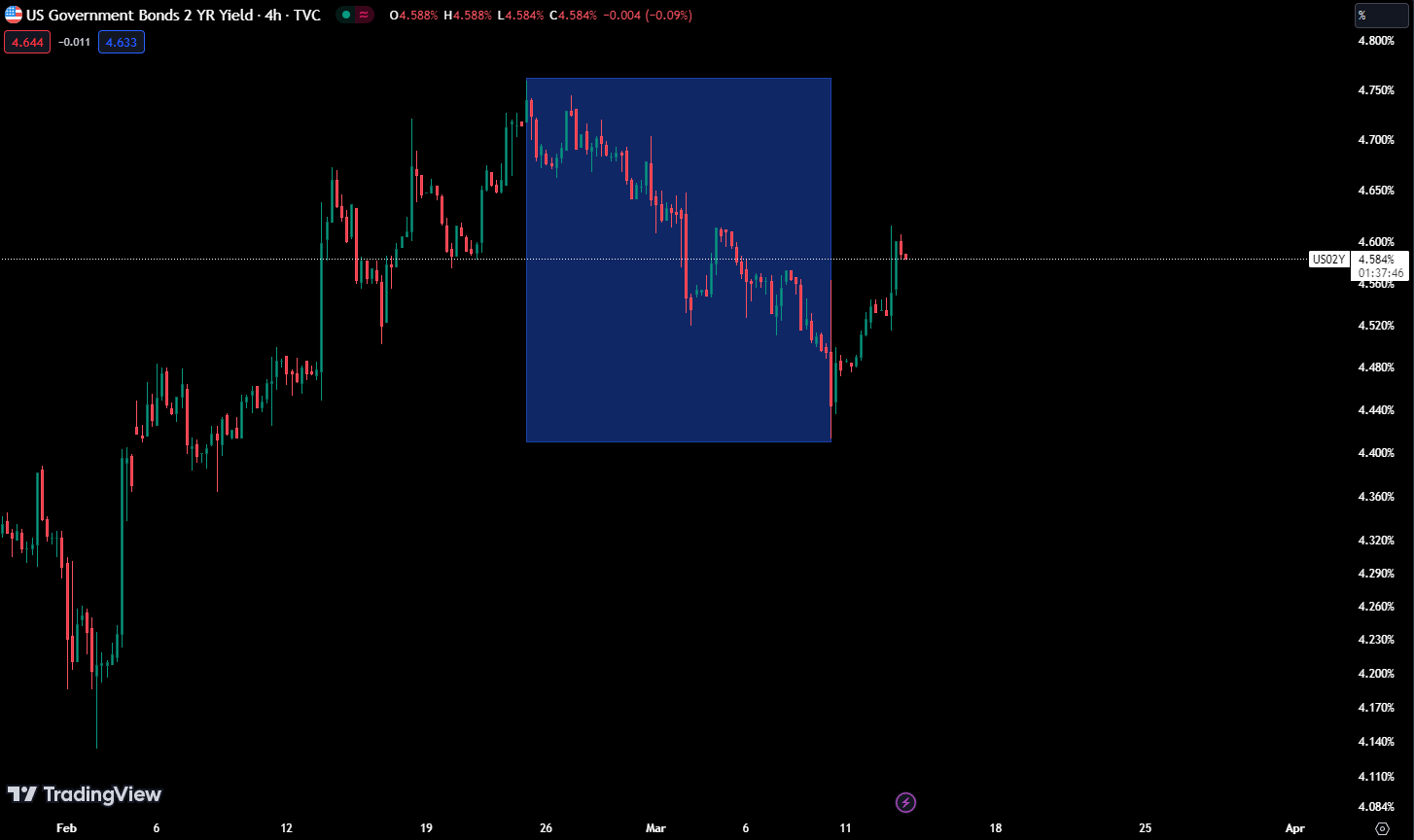Why did XAUUSD Rally so Much in the Last Week?
2024-03-13 14:25:20

In the recent economic landscape, the United States faced disappointing figures in unemployment and trade deficit data, amplifying negative sentiments in the market. The weak ISM, pending home sales, and Chicago Business barometer from the preceding week culminated in US macro surprises hitting their most adverse levels in over 18 months. This, in turn, triggered a decline in US real rates.
US02Y Government Bonds

Over the past couple of weeks, the bond market witnessed a significant rally, spanning regions and primarily driven by lower real rates at both the front and back ends of the yield curve, as we can see on the image above. While Euro Area sovereign spreads tightened, there is scepticism among rates experts about the sustained compression of these spreads.
During the last fortnight, most safe assets delivered positive returns, marking a reversal from earlier in the year. Gold emerged as the frontrunner, experiencing the strongest return in volatility terms—an almost 3-sigma upward movement over the period. The sensitivity to rates played a pivotal role in explaining the cross-section of safe asset returns and their robust performance in tandem with equity markets reaching new highs. Falling US real rates supported safe assets, exhibiting a positive correlation to rates, and applying downward pressure on the dollar. Consequently, the correlation of safe assets with equities weakened, bringing the equity/bond correlation close to zero. Notably, this correlation has been lower for European (German and UK) bonds, while the correlation with the dollar has turned more positive. Micro drivers such as speculation about the Bank of Japan preparing to exit its NIR policy and the unwinding of JPY-funded carry trades have likely contributed to the rally in JPY.
A weaker dollar also bolstered the (unhedged) return of European bonds, outperforming US bonds in vol-adjusted terms. Despite this, "safer" equities, such as S&P 500 low vol and SMI vs. DAX, continued to face challenges year-to-date, attributed to their overexposure to lagging defensive sectors (US utilities, European food & bev.) and underexposure to Tech stocks driving the market rally.
While implied volatility for most safe assets decreased, the MOVE Index is approaching its 2-year lows of around 100. However, the volatility of gold and JPY spiked following recent upward moves. Notably, the gold implied risk-off skew increased, in contrast with the equity risk-off skew that continued to grind lower.
The current asset allocation strategy remains in favour of bonds/cash (overweight equities, neutral commodities, and underweight credit). The expectation is that longer-dated bond yields will likely remain range-bound, serving as a buffer against potential growth shocks. European bonds are particularly favoured (overweight) compared to US bonds, while Japanese bonds are underweight. The rationale behind this positioning is rooted in the perceived hawkishness of the central bank cutting cycle pricing in Europe, with economists maintaining their baseline projection of five consecutive 25-basis point cuts by the ECB.
In the face of a potentially sticky inflation/rate shock scenario, the Dollar is considered a key hedge, and equity puts/collars are viewed as attractive portfolio overlays. Overall, the current market dynamics and the evolving global economic landscape are guiding strategic asset allocations to navigate potential challenges and capitalize on emerging opportunities.
Insights Inspired by Goldman Sachs: Credit to Their Analysis for Shaping Some Aspects of This Text
This content may have been written by a third party. ACY makes no representation or warranty and assumes no liability as to the accuracy or completeness of the information provided, nor any loss arising from any investment based on a recommendation, forecast or other information supplied by any third-party. This content is information only, and does not constitute financial, investment or other advice on which you can rely.
Try These Next
4 Powerful Tactics to Overcome the Most Costly Forex Mistakes
How to Master MT4 & MT5 - Tips and Tricks for Traders
The Importance of Fundamental Analysis in Forex Trading
Forex Leverage Explained: Mastering Forex Leverage in Trading & Controlling Margin
The Importance of Liquidity in Forex: A Beginner's Guide
Close All Metatrader Script: Maximise Your Trading Efficiency and Reduce Stress
Best Currency Pairs To Trade in 2025
Forex Trading Hours: Finding the Best Times to Trade FX
MetaTrader Expert Advisor - The Benefits of Algorithmic Trading and Forex EAs
Top 5 Candlestick Trading Formations Every Trader Must Know









